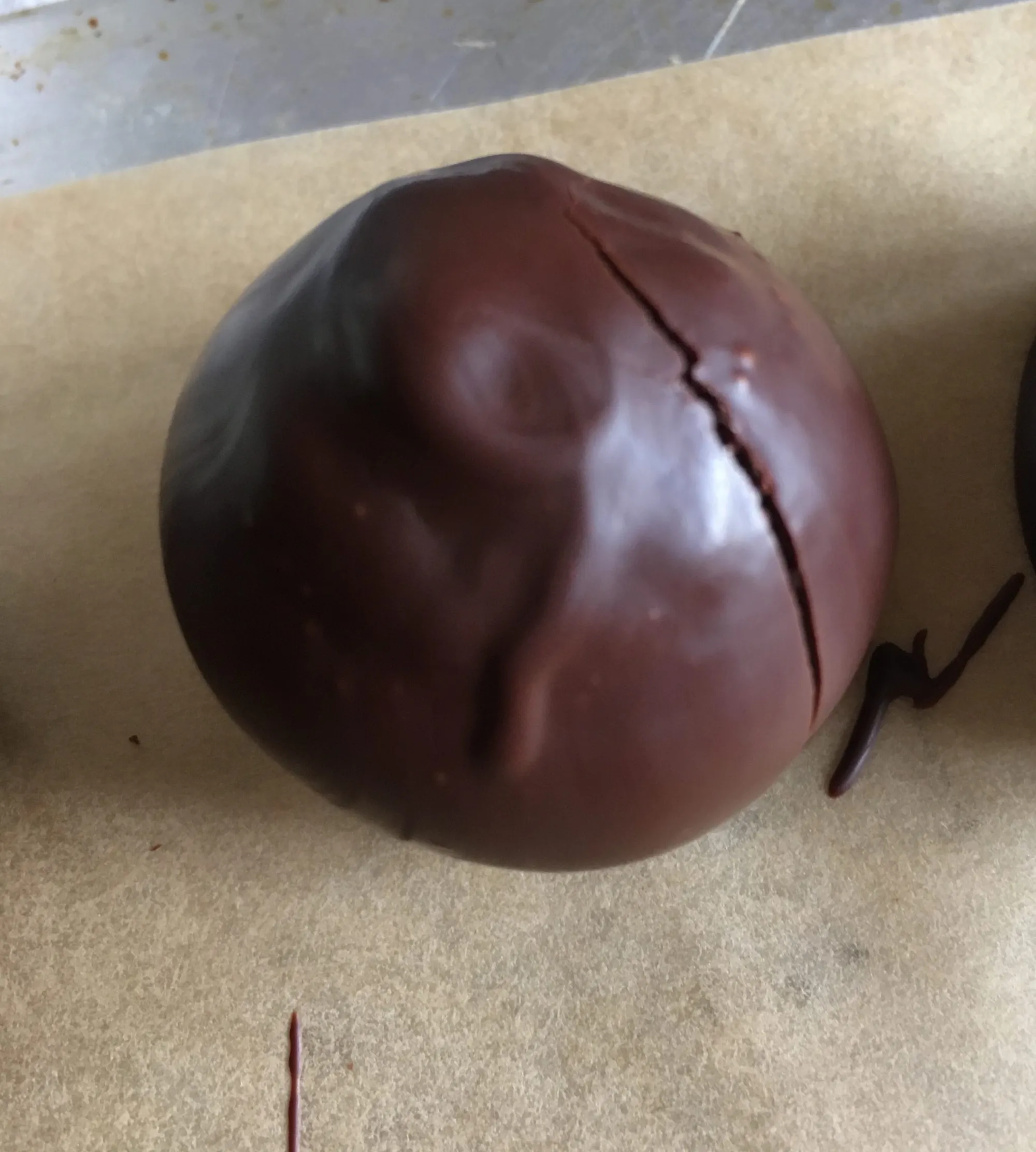The majority of my truffles either crack on the side as shown in the photo, or a little “button” pops out on the bottom. I have tried many things to remedy this problem, but none of them have worked. Without belaboring the details of what HAS NOT worked to fix the issue, I am hoping that someone out there has experienced this problem and can tell me what DOES work! Why is it happening? What can I do to fix it?
I don’t check this site often so sorry for the late response but I hope it helps. I hand dipped truffles for years and found that if I first applied a thin “crumb” coating it helps a lot. I don’t really “dip” the first coating just kept a bit of tempered chocolate in one palm and just roll the centers around in it to just give a light coating. The first coating can be messy and quick. After that had set you can “dip” the final coating in the traditional method. This also help the chocolate you’re dipping into not become too contaminated with the truffle filling. You can also successfully dip a much softer center using this method. Hope this helps.
Thanks. Without the details, it can be hard to troubleshoot. Broadly speaking, you might consider a chocolate that has milk fat in it, as milk fat softens the chocolate, provides a little give. My guess is that you’ve got cracking due to expansion/contraction of the center and chocolate at different rates – and if your chocolate is very rigid (ie no milk fat), it breaks instead of bends, and you get a crack. A few % milk fat in your chocolate might be helpful.
Sorry I haven’t responded for a little while. I have tried so many different temperatures of the various components that part of your query overwhelmed me. I have also tried varying the amount of liquid in my ganache recipe – all to no avail! My center:coating ratio is .65 oz. center with a finished weight of .80 -.85oz. And no, My chocolate has no anhydrous milk in it. The only dairy of any kind in my truffles is the cream I use in the ganache. The chocolate itself has no dairy.
Can you post your filling recipe, and the precise conditions you are making them under (ie temp of the centers when dipped, temp of the coating, temp of the cooling chamber, temp of the room you’re making them in, how long until the cracks show up, ratio of center/coating (ie weight of the center before coating, and after coating)). Cracks can be caused by all sorts of things – w/o having the details, it significantly reduces the odds of identifying which is causing it.. Do your chocolate have something called anhydrous milk fat (or milk fat) labelled on it?
My supplier says the chocolate I am using has a minimum of 70% Cocoa, 40.5% Cocoa Butter. So you are saying that is too high? I have experimented a lot with decreasing the temp difference between the centers and the coating by 1)increasing the temperature of the centers and 2)decreasing the temperature of the dipping chocolate. (The center is ganache – different flavors, it doesn’t seem to matter. And I use the same [dark] chocolate for the ganache that I use to enrobe.) I do not refrigerate the ganache, I just make it, let it set up overnight, then form it into balls and enrobe it the next morning. I have taken the temperature of my dipping chocolate down as low as 85.5 F. The truffles crack regardless of what temp the dipping chocolate is, and yes, it does get too viscous at a certain temperature and I have to warm it up.
@chocolategratitude –
From the look of this piece, it’s hand-dipped. A few thoughts come to mind right off the top of my head.
-) The shell is too thick. Could be too much chocolate, could be viscosity is too high.
-) What percentage couverture are you using? Usually, couverture for this application is 60% or less. Of course, that depends on the fat content (viscosity).
-) The difference in temperature between the center (too cold) and coating (too warm) is too great. The cool center is causing the warm chocolate to cool unevenly.
What is the center made of?
